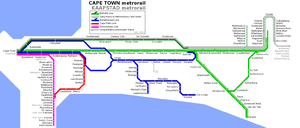| Metrorail Western Cape Region | |||
|---|---|---|---|
 A Metrorail train running near Kalk Bay station. | |||
| Overview | |||
| Owner | PRASA | ||
| Area served | City of Cape Town, Stellenbosch, Drakenstein and Swartland | ||
| Locale | Cape Metropole and surroundings | ||
| Transit type | Commuter rail | ||
| Number of lines | 4 | ||
| Number of stations | 122 (97 have ticket offices) | ||
| Daily ridership | 500,000 (2018)[1] | ||
| Chief executive | Richard Walker | ||
| Website | www | ||
| Operation | |||
| Operator(s) | Metrorail | ||
| Character | Suburban railway | ||
| Number of vehicles | 85 trainsets (1094 coaches) | ||
| Technical | |||
| System length | 460 km (290 mi) | ||
| Track gauge | 1,067 mm (3 ft 6 in) | ||
| Electrification | 3 kV DC overhead catenary | ||
| Top speed | 90 km/h (56 mph) | ||
| |||
Metrorail Western Cape is a network of commuter and suburban rail services in the City of Cape Town Metropolitan Municipality (metropolitan area of Cape Town) and in the surrounding towns of Malmesbury, Paarl, Stellenbosch and Wellington in the Western Cape province of South Africa.
It is operated by Metrorail, which operates commuter rail services in the major cities of South Africa. The network is fairly comprehensive, however, some key areas have no service, notably the Atlantic Seaboard, Western Seaboard and Durbanville.
There are 85 operational trainsets, made up of 1094[2] coaches. There are 671 scheduled trains per weekday, operating over 460 kilometres (290 mi) of the track to 122 stations and 4 halts.[3] In 2018 there were around 500,000 daily users of the service. The services are divided into three areas, each of which has various branches.
All services either commence or terminate at the main Cape Town station in the centre of the city, which has 24 platforms. All services are by electric multiple units, aside from the daily train to Malmesbury which is on a non-electrified line.
- ^ "#TrainArson: Significant drop in Metrorail passenger numbers". www.iol.co.za. 31 July 2018. Retrieved 7 November 2019.
- ^ The number of carriages currently is 1094 (according to Rolling Stock a number of wrecks were refurbished as part of the refurbishment programme and at least three complete train-sets were re-allocated from other regions since 2006). The total includes carriages currently being overhauled at contractors
- ^ "Fare Calculator". Metrorail Western Cape. 1 April 2012. Retrieved 20 June 2012.
